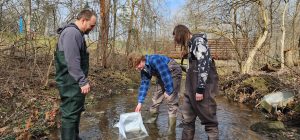 Two Daemen University researchers will lead a consortium of institutions on a statewide survey of the year-long effects of winter road salt on stream organism biodiversity and biochemical properties.
Two Daemen University researchers will lead a consortium of institutions on a statewide survey of the year-long effects of winter road salt on stream organism biodiversity and biochemical properties.
Dr. Sarah Whorley and Dr. Jeffrey Law, both associate professors of biology in the Natural Science Program, were awarded grants from the U.S. Geological Survey through the New York State Water Resources Institute, the Lake Erie Watershed Protection Alliance, and the Niagara County Soil and Water Conservation District.
 “For a long time, the effects of road salt were assumed to be minimal due to the short seasonality of its application,” Dr. Whorley said. “We only use road salt during the winter, and many people assumed that life was kind of ‘shut down’ during the winter, so the salt would just pass by. But there is now lots of research showing that the effects of salt are felt long after winter has passed.”
“For a long time, the effects of road salt were assumed to be minimal due to the short seasonality of its application,” Dr. Whorley said. “We only use road salt during the winter, and many people assumed that life was kind of ‘shut down’ during the winter, so the salt would just pass by. But there is now lots of research showing that the effects of salt are felt long after winter has passed.”
According to an annual survey conducted by Clear Roads, New York State applied nearly 850,000 tons of road salt during the 2021-2022 winter season, more than any other state.
Whorley added, “Given water’s importance to our region in terms of not only daily life but agriculture and recreation, learning about how all this extra salt is affecting our water quality and the organisms that live in those water bodies is going to provide important foundational information for making future decisions about how we approach winter road salt application.”
 In order to collect statewide data, Whorley and Law will work with Dr. Jeffrey Heilveil at SUNY Oneonta and Dr. John Wehr at Fordham University.
In order to collect statewide data, Whorley and Law will work with Dr. Jeffrey Heilveil at SUNY Oneonta and Dr. John Wehr at Fordham University.
The research team will conduct monthly sampling visits, focusing on three main areas of each stream: the water, algae, and invertebrates. Each stream will also be equipped with an embedded probe that will continuously measure chloride, one of the components of road salt, and the one that causes significant stress to organisms in excessive quantities.
At each site, the data will be downloaded and posted to a website that will host raw data as it’s generated.
 “Once the data is collected and analyzed, we hope that this provides the beginning of data that the state can use to update and refine their salt spreading practices,” Dr. Whorley said. “All our streams ultimately drain into the Great Lakes where fish populations are already struggling against warming temperatures and commercial fishing pressures. If our data can help ease up on one more stressor, then ultimately, our Great Lakes will be healthier for it.”
“Once the data is collected and analyzed, we hope that this provides the beginning of data that the state can use to update and refine their salt spreading practices,” Dr. Whorley said. “All our streams ultimately drain into the Great Lakes where fish populations are already struggling against warming temperatures and commercial fishing pressures. If our data can help ease up on one more stressor, then ultimately, our Great Lakes will be healthier for it.”
The project is set to launch in May, with monthly sampling continuing until April 2025. A full analysis is expected in 2026.
